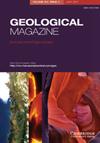尼科巴扇记录的印度次大陆中新世晚期到更新世的多阶段生态变化
IF 2
3区 地球科学
Q3 GEOSCIENCES, MULTIDISCIPLINARY
引用次数: 0
摘要
摘要印度次大陆、南北美洲和东非的现代草原在中新世晚期至更新世早期广泛扩张,可能是由于干旱加剧。利用C4光合途径的草地更能耐受高温和干旱条件,并且由于它们比利用C3途径的植物诱导的碳同位素分馏更少,C4草地的扩张可以通过土壤和陆源海洋沉积物中有机物的δ13C来追踪。我们提供了苏门答腊岛西部IODP U1480站点尼科巴扇沉积物中大量有机物的元素和同位素组成的高分辨率记录,以阐明恒河/布拉马普特拉河系统约1.5×106 km2流域内C3–C4植物过渡的时间和速度,它们继续向孟加拉湾供应大量喜马拉雅山脉衍生的沉积物。使用多代理方法来校正海洋有机物的影响,并解释不确定性的主要来源,我们认识到C4膨胀的两个阶段从~7.1Ma开始,在~3.5Ma开始,并在~2.5Ma逐步过渡。这些间隔似乎与印度洋和东亚季风增强期相吻合,以及北半球冰川作用从~2.7Ma开始的扩张。我们从深海获得的印度次大陆C4多阶段扩张的数据与印度西瓦利克人的陆地数据一致。本文章由计算机程序翻译,如有差异,请以英文原文为准。
Multi-phase ecological change on Indian subcontinent from the late Miocene to Pleistocene recorded in the Nicobar Fan
Abstract Modern grasslands on the Indian subcontinent, North and South America, and East Africa expanded widely during the late Miocene – earliest Pleistocene, likely in response to increasing aridity. Grasses utilizing the C4 photosynthetic pathway are more tolerant of high temperatures and dry conditions, and because they induce less C isotope fractionation than plants using the C3 pathway, the expansion of C4 grasslands can be traced through the δ13C of organic matter in soils and terrigenous marine sediments. We present a high-resolution record of the elemental and isotopic composition of bulk organic matter in the Nicobar Fan sediments from IODP Site U1480, off western Sumatra, to elucidate the timing and pace of the C3–C4 plant transition within the ∼1.5 × 106 km2 catchments of the Ganges/Brahmaputra river system, which continue to supply voluminous Himalaya-derived sediments to the Bay of Bengal. Using a multi-proxy approach to correct for the effects of marine organic matter and account for major sources of uncertainty, we recognize two phases of C4 expansion starting at ∼7.1 Ma, and at ∼3.5 Ma, with a stepwise transition at ∼2.5 Ma. These intervals appear to coincide with periods of Indian Ocean and East Asian monsoon intensification, as well as the expansion of Northern Hemisphere glaciation starting at ∼2.7 Ma. Our data from the deep sea for a multi-phased C4 expansion on the Indian subcontinent are in agreement with terrestrial data from the Indian Siwaliks.
求助全文
通过发布文献求助,成功后即可免费获取论文全文。
去求助
来源期刊

Geological Magazine
地学-地球科学综合
CiteScore
4.70
自引率
0.00%
发文量
111
审稿时长
3 months
期刊介绍:
Geological Magazine, established in 1864, is one of the oldest and best-known periodicals in earth sciences. It publishes original scientific papers covering the complete spectrum of geological topics, with high quality illustrations. Its worldwide circulation and high production values, combined with Rapid Communications and Book Review sections keep the journal at the forefront of the field.
This journal is included in the Cambridge Journals open access initiative, Cambridge Open Option.
 求助内容:
求助内容: 应助结果提醒方式:
应助结果提醒方式:


